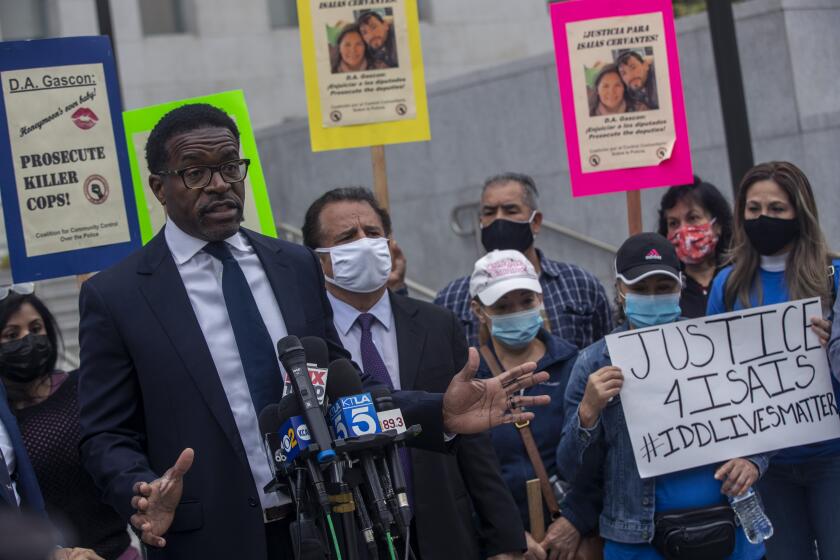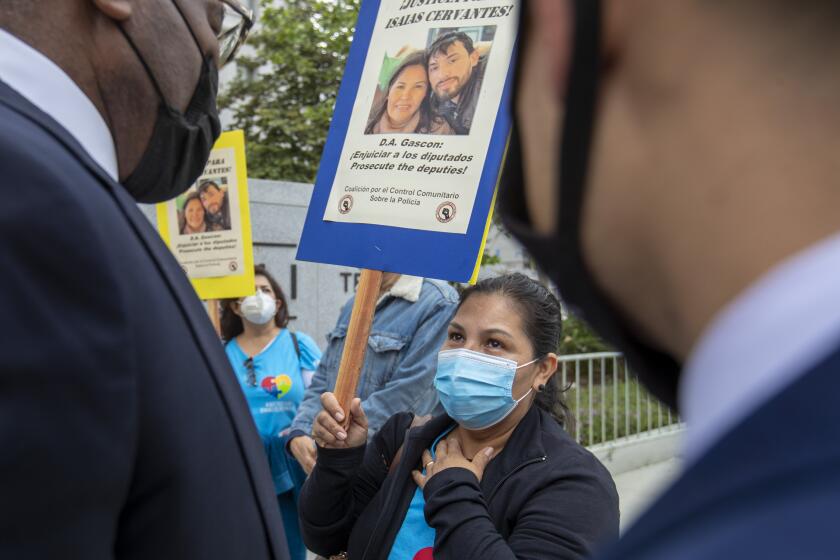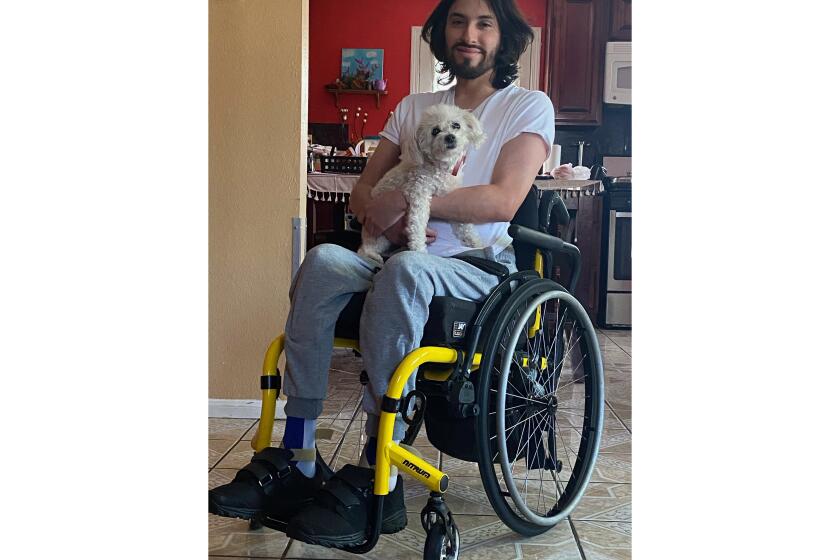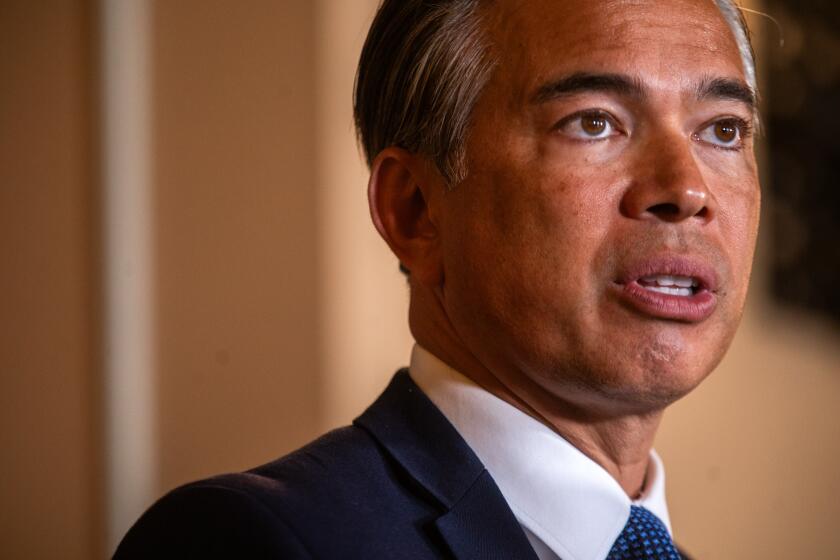They were wrongfully convicted as teens. Now L.A. County is paying them $24 million
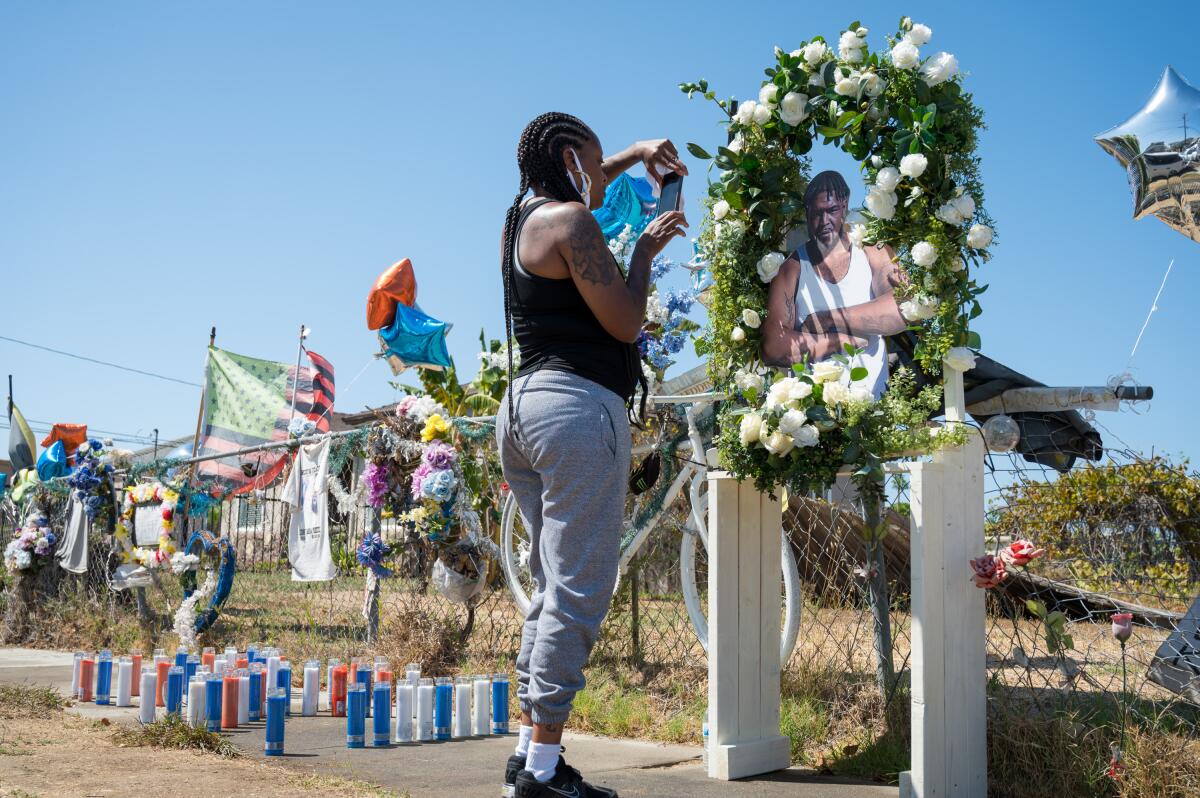
On June 28, 1997, Mike Tyson infamously chomped off a piece of Evander Holyfield’s ear in the third round of the heavyweight boxing championship.
Nearly three decades later, John Klene and Eduardo Dumbrique — then 18 and 15 — remember exactly where they were when it happened: They were at Klene’s family home watching the fight, surrounded by friends.
But that alibi, with its multiple witnesses, wasn’t enough to keep the teens out of prison when Los Angeles County Sheriff’s Department investigators wrongly accused them of murder. After 23 years behind bars based on what their lawyers described as “lies” and “made up evidence,” they were exonerated in 2021.
They filed a federal lawsuit the following year. On Tuesday, the Los Angeles County Board of Supervisors approved a $24-million settlement for the pair, who are both free now.
“I would trade any amount of money in the world to get my 20s and 30s back,” Klene said in a statement. “The worst thing about being wrongfully convicted for decades is coming to the painful realization that the system isn’t interested in the truth and your innocence means nothing to them.”
Since L.A. County Dist. Atty. George Gascón became the county’s top prosecutor in 2020, his office has overseen 14 exonerations, Gascón said in a statement Tuesday.
“I hope today provides some measure of justice for John, Eduardo, and their loved ones,” Gascón said.
The settlement was one of two multimillion-dollar payments that supervisors approved Tuesday. They also agreed to pay $3.375 million to the father of Dijon Kizzee, a Black man shot to death in 2020 by sheriff’s deputies who stopped him for riding his bike on the wrong side of the street.
Including this week’s settlements, the county has approved more than $66 million this year in cases involving the Sheriff’s Department, suggesting another year of record-breaking legal spending for the agency.
Deputies’ shooting of Isaias Cervantes in his own home will probably cost Los Angeles County $25 million without spurring a change in training or tactics to prevent something similar from happening again.
In response to a request to comment, the Sheriff’s Department reiterated the facts of each case, adding that Klene‘s and Dumbrique’s convictions were overturned “based on inconsistencies in the case” and pointing out that prosecutors later deemed Kizzee’s shooting “legally justified.”
The case that wrongly landed Klene and Dumbrique in prison for more than two decades began in 1997. That summer, according to the lawsuit, a Lawndale 13 gang member named Chad “Ghost” Landrum had a beef with Antonio Alarcon — the leader of a rival gang known as Lil’ Watts.
Around 11 on the night of the infamous Tyson fight, Landrum spotted Alarcon on a payphone outside a Hawthorne tire store, according to the suit. He pulled up in a dark sedan and opened fire, then fled.
Witnesses at the scene didn’t get a good enough look to offer law enforcement much more than vague tips: The shooter had been in a dark car, and people suspected the killing was gang-related. Investigators had little to go on.
Three days later, another Lawndale 13 member — Santo “Payaso” Alvarez — was arrested on suspicion of drug and weapons violations. He claimed he’d happened to overhear Klene, Dumbrique and a third man plotting a killing when he rode by them on his bicycle the day of the shooting and that he then heard them bragging about it afterward when he rode by them again a day later. When the Sheriff’s Department interviewed him, the lawsuit said, Alvarez openly admitted he was “just trying to talk his way out of jail.”
From the outset, there were clues that the story Alvarez told may not have been accurate. For one, he claimed he’d seen the teens driving around in another man’s green Ford Escort all weekend — but vehicle records showed the man hadn’t owned that car for months, according to the lawsuit.
Regardless, investigators released Alvarez a few hours after he implicated Klene and Dumbrique. But Alvarez’s vague admissions still weren’t enough to arrest the teens; so, county records show, Sheriff’s Department investigators visited the owner of the tire store to show him a photo line-up. The owner told them he hadn’t seen the shooter very well. But according to the lawsuit, the deputies then — in an unrecorded interview — told him which photographs to pick.
In mid-July, local police pulled Dumbrique over as he rode in a friend’s light-green, four-door Honda, and investigators decided maybe that had been the getaway car — not the green Ford Escort. So, according to the suit, they fabricated witness statements claiming that was the car used the night of the killing.
By approving a $25-million payout to a man shot and paralyzed by deputies with no discussion or call for change, the Board of Supervisors in effect said nothing went wrong in the incident.
Then, to further complicate matters, in late July the charred body of a transient who’d been set on fire was discovered in a San Pedro alley. Rumors circulated hinting Landrum and Alvarez had been involved in his death, and the Los Angeles Police Department began investigating them as suspects.
But, according to the lawsuit, instead of deciding his alleged involvement in a killing called Alvarez‘s credibility as a witness into question, the Sheriff’s Department conspired with police to pin the killing on an innocent woman, Susan Mellen.
Mellen was convicted and spent 17 years in prison before she was exonerated and released. She later sued the Police Department, saying the detective who handled the case knew a key witness against Mellen was “a habitual liar,” but failed to disclose that to the defense. The city ultimately agreed to pay her $12 million.
When the case against Klene and Dumbrique went to trial, the tire store owner testified he couldn’t identify them as the perpetrators. But prosecutors told the court that he’d recanted out of fear. The teens were both found guilty. Klene was sentenced to life in prison, and Dumbrique was given 29 years to life.
Then in 2012, Klene’s family learned Landrum wanted to confess, and they enlisted the help of a nonprofit organization — Innocence Matters — to look into the case. In a sworn declaration, Landrum admitted to killing Alarcon. It was an admission he’d nearly made years earlier, on the eve of the 1998 trial.
Back then, Landrum — who has since died — was in jail on another charge and agreed to come to the courthouse to answer questions about his role in the killing, according to lawsuit. While there, he got into a fight with another inmate, stabbing the shackled man repeatedly. Lawyers for the teens never managed to interview him.
After finally confessing in writing in 2012, Landrum made the same admissions in testimony the following year, admitting that Klene and Dumbrique had no involvement in the shooting and were not present for it. Their attorneys took the innocence claims to court. The two were exonerated and released in 2021.
Isaias Cervantes, a deaf and autistic man who was paralyzed after a 2021 shooting by a sheriff’s deputy, was awarded $25 million in a settlement.
“The lies behind John Klene and Ed Dumbrique’s decades-long wrongful imprisonment were exposed before their criminal trial began when a witness described how a Sheriff’s Department detective made up the evidence against them,” Klene and Dumbrique’s attorneys, Deirdre O’Connor and Nick Brustin, said in a joint statement. “But the detectives lied again to cover up their misconduct, and the Sheriff’s Department let them. John and Ed are hopeful that the magnitude of this settlement leads to a careful evaluation of how many other wrongful convictions were caused by these same systemic failures.”
They said Klene plans to use some of his settlement to help mentor at-risk youths, while Dumbrique intends to further his work on prison reform.
“My time in prison amounted to the worst nightmare one could ever dream of, only mine was a reality,” Dumbrique said in a statement. “California has the most dangerous prisons in America. Children do not belong there.”
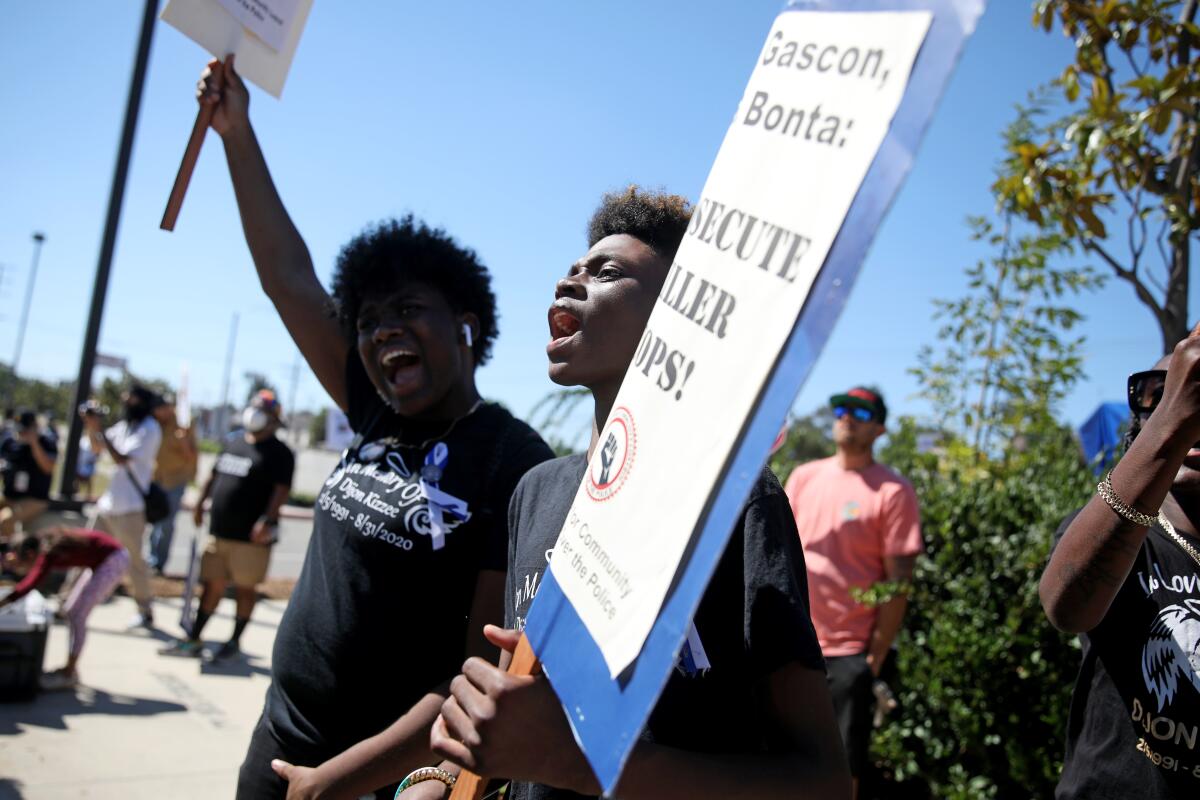
The five county supervisors unanimously approved both the $24-million settlement — as well as the Kizzee settlement — as part of the meeting’s consent agenda, a package of items that are considered noncontroversial and are not discussed by the board.
The 2020 shooting of Kizzee, 29, set off days of protests by demonstrators infuriated by the death of another Black man whose minor traffic violation had led to deadly force. An autopsy commissioned by the family found Kizzee, who had been biking when deputies stopped him, was struck 15 times by deputies after he fled on foot.
Edwin Kizzee, Dijon’s father, sued the county in September 2021, accusing deputies of stopping Kizzee purely because of his race “as opposed to any legitimate law enforcement purpose.” The family had initially sought $35 million in damages.
On Aug. 31, 2020, Kizzee, an unemployed plumber living in the Antelope Valley, had been visiting friends in South Los Angeles. He was on his bike when deputies Christian Morales and Michael Garcia stopped him for riding eastbound in the westbound lane, according to the deputies’ account of the incident detailed in county records. Kizzee tossed his bike and fled on foot. When the deputies caught up with him, Kizzee struck one of them in the chin, and a handgun he was carrying fell on the ground.
As Kizzee picked it up, the deputies shot him multiple times, the department said. They fired another volley of shots after he collapsed.
A settlement is said to be near in the California Department of Justice’s sweeping investigation of the L.A. County Sheriff’s Department.
Civil rights attorney Dale Galipo, who represents Edwin Kizzee, said the fact that Kizzee had a gun complicated efforts for a larger settlement. But he said his team had been able to prove that the majority of the deputies’ shots were fired after Kizzee was on the ground and his gun was six feet away — contradicting officer’s claim that they fired most of the shots while Kizzee was upright.
“The majority of the shots happened when he was on the ground and unarmed,” said Galipo, adding much of the outcry over his client’s death stemmed from the belief that his client would not have been stopped if he were white. “A similar incident would not have happened in Beverly Hills.”
Prosecutors declined to press charges against the two deputies, saying they “reasonably believed” the force was necessary. The deputies said they fired the second round of shots after Kizzee reached for his pistol a second time, though some witnesses disputed that.
The encounter was recorded on camera, but the video is low-quality, and the altercation is partially obstructed. The department did not start wearing body cameras until a few months after Kizzee’s death.
Both deputies remain with the agency, according to a database of county employees.
More to Read
Sign up for Essential California
The most important California stories and recommendations in your inbox every morning.
You may occasionally receive promotional content from the Los Angeles Times.
